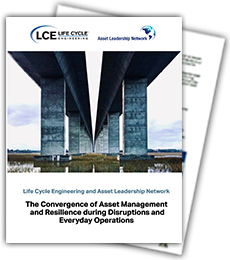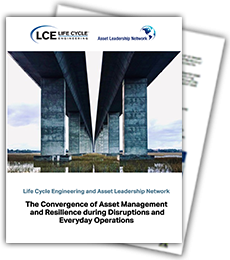The Convergence of Asset Management and Resilience during Disruptions and Everyday Operations
By Jesse Rothkopf, Managing Principal, Life Cycle Engineering and
Michael Bordenaro, Communications Director, the Asset Leadership Network
Executive Summary:
- Integrating resilience planning along with a structured asset management program will help better prepare your organization to achieve its strategic mission during everyday operations and during disruptive events.
- Lessons learned from preparing for and responding to disruptions can help organizations realize the benefits and value from applying similar efforts to everyday operations, and vice versa.
- When updating their resilience plan, smart enterprises will look beyond their immediate organizational boundaries and extend their planning to involve the communities in which they operate. Engaging public and private stakeholders is consistent with ISO55000 guidance and will strengthen organizational and community resilience while creating synergistic opportunities for improved performance.
Takeaway:
- Resilience planning is essential to asset management planning.
- A structured Enterprise Asset Management (EAM) program that includes resilience planning is a force multiplier that benefits all stakeholders.
- The ISO 55000 structure for asset management is a viable and holistic approach that can help organizations improve mission success during disruptions and in everyday operations.
- Asset management and resilience planning follow a natural maturity curve and are never complete. Organizations can improve their maturity regardless of where they currently reside on that curve. Experience tells us that greater maturity in these areas typically results in substantial organizational benefit.
- The time to update your asset management and resilience planning is NOW.
Introduction
Resilience across communities and public infrastructure involves much more than an individual organization’s response to an emergency. It reflects the ability of disparate public and private sector organizations and stakeholders to collaborate as effectively as possible to anticipate, prepare for, respond, and recover when incremental or sudden disruptions occur.
Organizations tend to think of their mission and their assets as separate from the many stakeholders and diverse infrastructure assets that enable their success. But roads, electricity, gas, water, communication services, and public infrastructure are essential to almost every organization – private or public. The responsibility to provide effective public infrastructure assets extends beyond the specific Department of Transportation, utility, or local agency that is charged with their safe and practical delivery. Private and public asset owners must see their operations as part of a larger system and incorporate collective resilience into their asset management policies, strategies, and objectives.
The ISO 55000 structure for asset management acknowledges that all relevant stakeholders should be involved in creating an organizational Strategic Asset Management Plan (SAMP). This requirement suggests that your SAMP must include tangential stakeholders. Even if your organization provides its own energy generation or maintains its own roads, some level of coordination with another energy provider, or with the local Department of Transportation, is essential during normal operations as well as times when emergency response is activated.
During emergencies and disruptions our need for interactive involvement across stakeholders and infrastructure is most apparent. A structured asset management program will greatly enhance resilience and stakeholder involvement, and ensure mission success during normal operations as well as emergency situations. With the inclusion of resilience planning, the structured asset management program can shift response to disruptive events from chaos to clarity. It can also help your organization mitigate very real problems that might impact your operations and your community’s recovery.
As we have learned from the COVID-19 pandemic, governments, hospitals, first responders, citizens, and even industry all have critical roles to play in preparedness, response, and recovery. Each of these parties will benefit from greater collaboration across the resilience and asset management planning processes. But first, organizations must collectively acknowledge, understand, and be ready to work interactively with all key stakeholders to ensure mutual mission success.
The organizational mission for asset-intensive enterprises in either public or private sectors is directly linked to their physical assets and the alignment of the organization’s people, processes, and technology to maximize the effectiveness of those physical assets. Maintaining mission readiness for these assets is difficult enough during normal operations. In the case of a local, statewide, national, or global disruption, the added challenges make readiness even more difficult and necessary.
When major disruptions occur, stress levels are high and the focus on asset management is often diluted; supply chains can be disrupted and workforce collaboration is often strained. Mid-crisis is not the time to deploy unfamiliar asset management systems and practices, develop a new supply chain, or ask your workforce to roll out unfamiliar protocols for infrequently used technologies.
Because resilience is part of an effective SAMP, preparing for emergencies and major disruptions is a significant asset management issue. Where possible, these events should be addressed with the same systems, processes, and people employed in your normal day-to-day operations.

To learn about six key asset management concepts that enhance resilience, read the whitepaper.
The Convergence of Asset Management and Resilience during Disruptions and Everyday Operations
By Jesse Rothkopf, Managing Principal, Life Cycle Engineering and
Michael Bordenaro, Communications Director, the Asset Leadership Network

